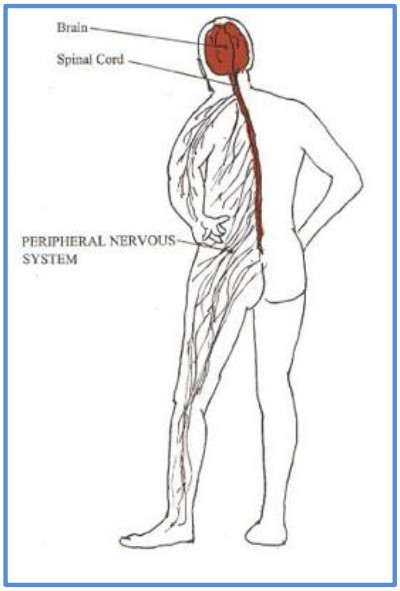Chronic Inflammatory Demyelinating Polyneuropathy
What does this mean?
This is medical jargon, but it provides useful information about the disease.
Taking each word in turn:
Chronic means that the disease occurs over a long period of time.
Inflammatory indicates that the nerve damage occurs due to the presence of inflammation, a complex process involving the immune system.
Demyelinating means the damage affects the protein coating (myelin) around the nerve fibres.
Polyneuropathy means that the disease affects more than one nerve.
What is actually going on?
There is damage to the nerves connecting the brain and spinal cord to the muscles in the arms and legs. These nerves are the peripheral nervous system (see picture).

What causes the damage to the nerves?
There is strong evidence that the problem lies with the immune system (the body’s defence mechanism) acting against the coating of the peripheral nerves. It is not known exactly why the immune system does this. It is neither inherited from your parents, nor does it spread from one person to another.
How does the nerve damage cause my symptoms?
This leads to malfunction of the nerves. This interferes with the signals going from the brain to the muscles, causing weakness of the affected muscles. It also stops sensations returning from the skin to the brain. This often causes abnormal sensations in the arms and legs such as numbness and tingling.
Is everyone affected the same?
No. Some people experience only minor symptoms whilst others experience severely disabling symptoms. Most people fall somewhere between these two extremes.
How will the disease affect me?
This also varies from person to person. Some people suffer relapses, where the disease keeps on returning after periods of stability. Other people have a single episode which resolves and does not return.
Is there any treatment available?
There is treatment available which focuses on ‘dampening down’ the body’s immune system. Treatment is based on the principle that the abnormality is in the body’s immune system acting against the nerves. Physiotherapy and occupational therapy are also important parts of treatment for many people.
What are the different treatments affecting the immune system?
The options include steroids, immunoglobulin therapy, immunosuppressive drugs, or plasma exchange. They all act on the immune system in their own way. The choice of treatment is tailored to each individual patient and will be discussed prior to prescribing.
How do the treatments work?
They suppress the immune system’s activity against the nerves. This reduces the amount of inflammation in the nerves and reduces the nerve damage. Physiotherapy and occupational therapy maximise your physical potential, working on strength and function of the muscles.
Can my nerves repair themselves after damage?
The protein coating around the nerve can regenerate over weeks to months once the inflammation has settled, and symptoms can gradually improve.
Will the treatments cure me of CIDP?
No. The treatment does suppress activity of the disease by dampening down inflammation of the nerves. We are only able to treat the effects of the disease, not the disease itself. Until more is known about the causes of the abnormal immune response against the nerves, this will remain the mainstay of treatment.
Does everyone benefit the same from treatment?
The response to treatment varies widely between people. This is why treatment courses are tailored to individuals.
What benefit will I get from treatment?
Treatment generally speeds up the rate of recovery and also helps to prevent further nerve damage occurring. However, as well as the response to treatment being variable from person to person, it can also vary in the same person throughout the course of the disease. Your treatment will be tailored according to your individual need.
Is treatment safe?
On the whole all the treatment options are safe. Serious side effects are uncommon. However, the treatments are given under supervision and you will be monitored for side effects.
Do I need to have treatment?
Treatment is recommended in most cases and is tailored to each individual. Without treatment, the nerve damage can improve. However, recovery can be very slow. The nerve damage can also become progressively worse or follow a relapsing-remitting course.
- Last Updated:01 June 2022
- Review Date:01 June 2025
- Author:
- Summary:
There is damage to the nerves connecting the brain and spinal cord to the muscles in the arms and legs. These nerves are the peripheral nervous system